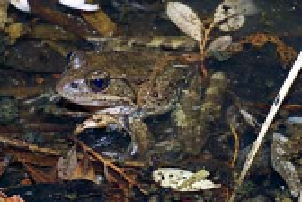Biology Reference
In-Depth Information
ments within Sonoma, Napa, and Marin counties, its limited range puts it at risk of
extirpation. However, it can still be found in selected reaches of Lagunitas and
Olema creeks.
YEAR LISTED
: 1988
SIZE
: 2.2 inches
POPULATION:
unknown
California Least Tern
(
Sterna antilla-
rum browni
) Orange-yellow legs and bill
plus a black cap with white forehead
distinguish this bird from other terns
diving into surface waters to catch smelt
and anchovy. Though human distur-
bances have spoiled many of the open
beach areas where these members of
the gull family prefer to nest, a well-
protected breeding colony on the Ala-
meda Wildlife Refuge now hatches up to
one-half of all Least Tern fledglings in
the state.
YEAR LISTED
: 1970
SIZE
: 9 inches
POPULATION AT LISTING
: ~300-1200 pairs
POP-
ULATION TODAY
: 2,500 in 1995; as many as 13,000 today
California Least Tern. (Max Eissler)
California Red-legged Frog
(
Rana
draytonii
) In “The Celebrated Jumping
Frog of Calaveras County” by Mark
Twain, a California Red-legged Frog out-
jumps the competition thanks to a little
skullduggery and buckshot. This largest
of North America's native frogs once in-
habited cool, deep pools throughout the
mountains and foothills of the Bay Area
as well as up and down the state. How-
ever, heavy harvesting for San Francisco
dinner tables in the late nineteenth century, the loss of foothill ponds and wet-
lands to cattle grazing and city blocks, and the arrival of new predators including
non-native fish and the North American Bullfrog have drastically reduced their for-
mer range.
YEAR LISTED
: 1996
SIZE
: 1.75-5.25 inches
POPULATION
: unknown
California Red-legged Frog. (Chris
Brown)
Chinook Salmon, winter-run
(
Oncorhynchus tshawytscha
) Also known as King
Salmon for their majestic size—up to 85 pounds—most winter-run Chinook gener-
ally return from the ocean from November through April to fight their way up the
Sacramento River and reproduce. As recently as the 1960s, more than 100,000
winter-run Chinook Salmon returned to the mainstem Sacramento River to spawn;
by 1991, degraded stream habitat and migration obstructions such as dams had
reduced the run to just an estimated 211 fish.
YEAR OF FEDERAL LISTING
: 1990, listed
as threatened; 1994, uplisted to endangered
YEAR OF STATE LISTING
: 1989, listed as



